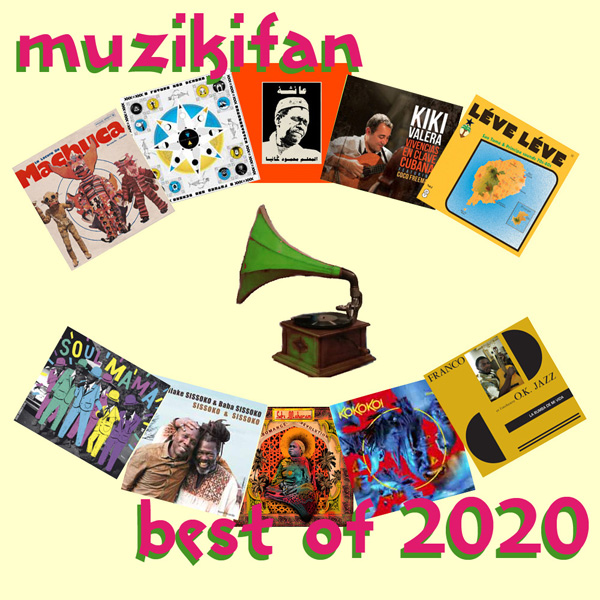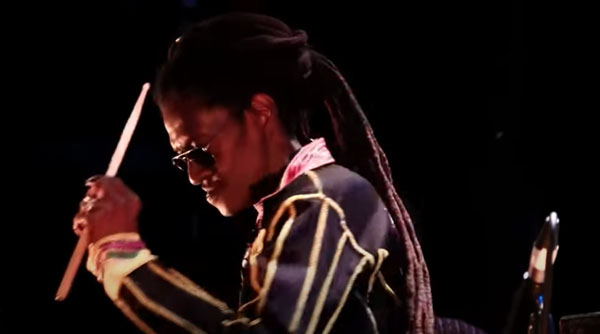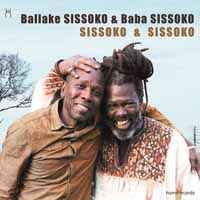
|
BALLAKE SISSOKO & BABA SISSOKO
SISSOKO & SISSOKO (homerecords)
I had no idea of this album's existence until a friend sent me the Bandcamp link. I was enthralled and immediately bought it. Had I heard it sooner it would be on my top ten discs of 2019 so it will have to be a holdover for this year's "best of" list. Ballaké plays kora -- which I like less than the other Malian stringed instrument the ngoni -- but he is a fine player and his companion has a nice bluesy tinge to his vocals. In fact, in his cousin Baba Sissoko, Ballaké has found the perfect foil: a percussionist who also plays ngoni and sings. The kora is a constant but the guest is a wizard on many instruments so the varied accompanying change-ups keep it interesting. Both have toured the globe with other artists but this is the first time the duo have recorded together. So they delved back into their childhood when they were musical cohorts in the Ensemble Instrumental Nationale du Mali, both of them growing up and studying, as griots, to replace their fathers in that group. Ballaké's father was the distinguished Djelimady Sissoko who is name-checked in "Djamu Djakoli." The new generation take the primordial sound of plucked strings and slapped skins and direct its warmth to us. It's a great experience eavesdropping on their musical dialogue and their shared heritage and residual youthful competitiveness pushes them to great innovation. . |
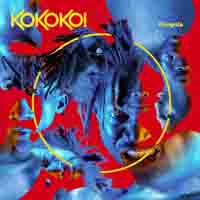
|
I heard this band on NPR's Tiny Desk Concert and was eagerly awaiting news of their album, only to discover that it came out in Summer 2019. So much for being in the loop. They have taken tracks from previous singles and EPs and assembled a mesmerizing collage of sounds. Kokoko! means knock knock knock, as in the African Team song "Kokoko! Qui est la?" They are from Kinshasa, Congo and use some rudimentary home-made instruments such as pots and pans. The title means "The Key" and it's a lo-fi paean to chaos and the order that can be assembled from disparate parts. There's no info on them (welcome to the world of digital downloads) but the Tiny Desk video depicts Makara Bianco, the singer, using a megaphone to get a "masked" voice. There's a white guy on synth and electronics (he's Débruit: French for "Noise"), a drummer with a couple of drums with polythene and tape holding them together. There's a funky homemade marimba made of different sized plastic milk bottles (a lactophone?), a guy beating on metal pipes, and a three-string home-made guitar, that has been electrified. They are all wearing jump suits (like Devo?) and it is wickedly hypnotic. "Likolo" the opening cut could go on for ever, it is so brilliant. This is a great cognitive leap forward for the electric likembe bands of Génération Congotronix, who had outside producers reworking their material. It is better to have the remixing be part of the original production as Débruit manages so effectively here. On "Tongos'a" the marimba player switches to an electric bass, the guy who was beating on metal pipes (Love Lokombe?) attacks a likembe, not with his thumbs but with metal rods. He also plays a one-string satonge attached to a tin can that recalls Roger, the genius kid in Staff Benda Bilili. The sound is big, thanks in part to the echo and reverb coming through the producer's rig. Débruit also loops in drum samples, I think. It's very engaging and weirdly, in places, reminds me of Baiansystem from Brazil, though i don't think they have encountered one another. But who knows, the globe is shrinking... like Baianasystem they are massively creative and the whole album is laden with great hooks. . |
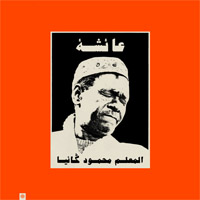
|
MAALEM MAHMOUD GANIA
AICHA (HiveMind)
It's only posthumously that Mahmoud Gania's work has gained wider appreciation. While available in Morocco on tapes from Tichkaphone and other labels, there have only been a few CDs released outside his homeland, and now here's a second LP of his music from Hive Mind. Gania's music may be very repetitive, but it grabs you by the vitals. His up-front bass-like 3-string Guimbri thuds and pumps while the percussion clacks relentlessly. The krakrebs sound like horses galloping across cobbled streets, but is this a well-known sound in Morocco? I guess it is. And galloping into your imagination, Hive Mind brings us another wonderfully dreamy set, perfect for late night contemplation. It is Gnawa ritual music, with call and response vocals, guaranteed to get the mystics gyrating and moaning along. The Gnawa were brought to Morocco as black slaves so are stateless and landless people who sing about "Sudan," meaning, not the modern country, but black sub-Saharan Africa from whence they were brought. They make a rhythmic and direct appeal to various saints and God, not to mention the prophet Muhammad, crying out for hope, redemption and spiritual grace. The lyrics are presented in the booklet, with translation, which is a plus, but quite often turn out to be simply "A bangara bangara / A bangara bangara / A bangara bangara / A bangara bangara," which may not even be comprehensible to initiates. Gania worked in many musical contexts: alongside jazz musicians who sought him out (even if they couldn't communicate with him verbally) or in weird hybrid world music mixes, such as the psychedelic cassette you can find on the "Moroccan tape stash" blog, but what he does best is this all-night trance music perfectly captured here. .
|
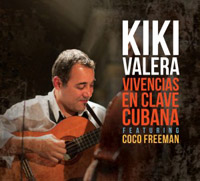
|
KIKI VALERA
VIVENCIAS EN CLAVE CUBANA (Origin 82790)
Kiki Valera comes from a family which has been playing music in Cuba for well over a century. The family thought it important to collect the musical heritage of the Sierra Maestra region and put out albums of traditional music from their base in Santiago de Cuba (Comprehensive Anthology of Son, two discs on Egrem, 1982). A couple of decades ago OCORA, the publishing arm of radio France, toured the world looking for the best examples of every type of music in every country (I have a shelf of African traditional music they recorded). Ocora's engineers captured a set of classic son and boleros by La Familia Valera Miranda, so this was high praise to be the choice from Cuba. While most son groups feature the six stringed tres, Kiki plays the cuatro which his father taught him. It has additional low strings, tuned F sharp-D-A-E. In addition to cuatro and guitar, Kiki is backed up by upright bass, congas or bongos, and a trumpet. His old friend Coco Freeman is lead singer and there are a couple of coro singers. So it's a small group but they pack a punch. Coco has sung with NG la Banda and Adalberto Alvarez y su Son, a second vocalist Carlos Cascante has won three Grammies with Spanish Harlem Orchestra; the trumpeter, Alexis Baró, has backed Omara Portuondo and appeared in Cubanismo, while bongocero Pedro Vargas has featured in the sublime band of Barbarito Torres. The album was recorded in Seattle and mixed in Santa Cruz, California. There are a dozen original compositions but all of them are in the familiar son style, and in fact it is as well recorded and engaging as those great albums by Barbarito Torres and the other touchstone of great contemporary Cuban Son, grupo Sierra Maestra. Valera is a potent performer with incredible skill and jazz-like invention in his solos; you can tell the band are used to jamming because they interact perfectly when he takes a new turn in a melody, such as the break of "Ferecia." For the smoking "Desenfreno," the trumpet has been doubled; in addition to congas and bongo, there is the other percussion we associate with Cuban combos: maracas and cowbell. Above all, the musicians emanate the joy they are feeling in playing this music together.
.
|

|
SITI MUHARAM
SITI OF UNGUJA (ROMANCE REVOLUTION ON ZANZIBAR) (OntheCorner)
This album made a stir before it even appeared: the vinyl sold out on pre-order, it was the Guardian album of the month and it netted a 3-page feature in Songlines, the world music/travel magazine. From the lush album art to the grooves it's a superb production. In fact the production, by Sam Jones, is what drew me to this as normally I don't consume a lot of taarab. The album was recorded in ten days but there was a lifetime, in fact several lifetimes of preparation. The singer Siti (Lady) Muharam is great-grand-daughter of Siti Binti Saad who was known as the Mother of Taarab. For her part she brought the music from the Sultan's court to the streets, singing in Kiswahili and adopting the local kidumbak percussion. The Unguja of the title is the largest island of Zanzibar, which lies 30 miles off the coast of Tanzania. Binti Saad was not only a pioneer woman singer in this style but she was the first recording artist from Zanzibar, sailing to India in 1929 to record. Her shellac discs sold in tens of thousands. The main instrument is a qanun, a zither-like stringed instrument, played by Gora Mo Gora. Matona, the arranger, is also heard on violin and oud. Indian and Arabic influences are apparent but the subtle hints of studio effects push this over the frontier from historic to decidedly modern. Echoey bass clarinet (sounding like a ney), and contra bass were overdubbed in London, plus emphasis was added to the percussion. The notable lack of the typical large string section of taraab make it sound fresh and less of a Sultan's post-prandial lethargic drowse. The liner notes repeat themselves but it seems as though they took the original songs of great-granny and remade them, keeping the spirit but adding a modern framework. .
|
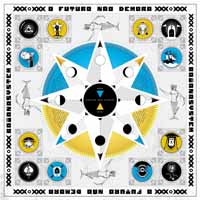
|
BAIANASYSTEM
O FUTURO NAO DEMORA (No label)
This band is tricky--they don't sell CDs: you can stream the album free on many platforms such as Spotify but it remains intangible, and for me artifactuality is an important element of music. Not just the possession factor but for classification, filing and retrieval. (My last computer meltdown wiped out a lot of music I had stored on it.) As innovative as their 2016 Duas cidades, this album has hip hop lyrics delivered over a strong dubby bass and Afro-brasilian drumming, with a wash of Hammond organ, electronica, a real horn section and a light rinse of berimbau and other instruments local to Salvador da Bahia, the colorful heart of Brasil. Among the tropical rhythms there is a lot of modern samba and even afoxé (also called ijexá), recognizable in the repique drum riffs on the downbeat. For this they enlisted a bloco of ten drummers! But in general they wear the folklore lightly, adding irresistible guitar hooks and the oddly insistent synth keyboard part guaranteed to give you earworms. Adrian Sherwood was brought aboard to tinker with the dub aspects of "Navio," where vocalist Russo Passapusso sounds like an old pirate. "Bola de cristal (Crystal ball)" and "Sulamericano (South American)" are stand-outs. The latter features Manu Chao and recaptures the excitement of their first hit "Playsom." While there is nothing quite equal to "Playsom" or their follow-up single "Invisavel," this is a solid entry from Baianasystem. Titled "The Future wont wait," their message is a heartening reaffirmation of the urgent necessity of ecological salvation, so important in this day and age, not just in Brasil where the Amazon is at a tipping point.
. |
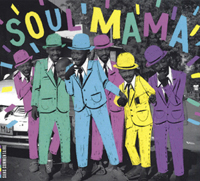
|
MAMA SISSOKO
SOUL MAMA (NoComment)
Mama Sissoko's father played ngoni but wanted his son to be a mechanic and sent him to Bamako to study with his uncle. But his uncle was also a musician and the lad wanted nothing more than to master the strings. When he was 21 the president of Mali heard him performing in a traditional festival and asked him to join the national Instrumental Ensemble. When Mama took up guitar it was from the perspective on an ngoni player. In the early days of Independence the radio stations played a lot of American music and Mama particularly liked soul music, which made a lasting impression on him. From his days with National Badema, one of the regional bands of Mali, Sissoko made his name as a solo guitarist and accompanist to Ali Farka Touré. Later he guested on the stellar 2008 recording of ngoni master Issa Bagayogo, Mali Koura. Now Sissoko is 75 and has brought up a virtuoso nephew who joins him on this disc, playing second guitar. One of his sons is also present, having cut his teeth as bassist in Salif Keita's band, and other Sissokos are in the chorus. The spirit of departed singer, Moussa Doumbia is felt. The late great sokou-player Zoumana Tereta appears on "Niama Toutou" and "Homage to Ali Farka Touré." We will miss his elegant presence. We hear Makan Camara on drums. There is a warm Hammond organ sound (by Manjul Souletie, a French rasta producer) which makes a lovely counterpoint to the clipped guitar and bright excursions from the ngoni (played by Abdoulaye "Kandiafa" Kone). This is another triumph, up there with what I call Sissoko's "Mini-Wheat" disc, Soleil de Minuit which came out on Buda two decades ago. .
|
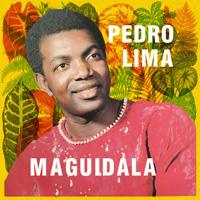
|
PEDRO LIMA & OS LEONENSES
MAGUIDALA (Bongo Joe)
I don't know if it's creeping senescence or whether I am fortunate to be on the receiving end of some great old music at this point where I find reissues more compelling than new releases. I do check out the new stuff, and find Bandcamp's recommendations most useful, but as my old sidekick DeeJay IJ said to me recently: We used to be the trendsetters, no one told us what to listen to! Now, we are looking for stuff like everyone else. This uptempo music from São Tomé was called ouxa, and in 1985 when this album was first released, Pedro Lima was the king of the islands. His band also incorporated the rumba-soukous hybrid pioneered in West Africa by the African All-Stars, guitarists like Lokassa Ya Mbongo, Dizzy Mandjeku, Syran Mbenza and Dally Kimoko. You hear this especially in the break-down of songs like "Lionensi sá tindaji." Being a Portuguese ex-colony there are also elements of other Lusophone musics, like the rebita beats of Angola. In fact the Leonenses often made trips to Luanda to perform and record. The tracks stretch out and are quite simple, relying on the propulsive percussion on the reco-reco to keep afloat while the wiry rhythm guitar of Pety-Zorro twists and turns. This is great music and welcome as an ocean breeze on a hot day.
. |

|
FRANCO & OK JAZZ
LA RUMBA DE MI VIDA (Planet Ilunga 8)
This well-conceived and sequenced album tells the story of OK Jazz's development during the 1960s. But it starts with the period 1970-72 and the Authenticité movement when Zaïre was reaching back into its history to fashion a new identity as distinct from a colonial one. At that point some of the elders of the music were brought back to public attention: we hear Camille Feruzi and his accordeon on the opening two cuts, as well as a composition by Ngoma label stalwart Manuel d'Oliveira. In addition to listening to the elders, Franco also changed his approach to the guitar, abandoning the plectrum for finger picking, using the plucked sound so closely identified with his playing, heard clearly here on "Mosala Etindi" where it is juxtaposed with punchy horns and "Casier Judiciare," a ballad about polygamy and divorce.
The second side takes us back to 1961 when Franco, unhappy with the sound of the new 45s from the Loningisa label in Leopoldville, turned to Joseph Kabasele who generously invited the band to Brussels to record there for his Surboum African Jazz label. The stripped-down band included Albino Kalombo on trumpet and Isaac Musikewa on sax, with Franco, Kwamy & Mujos on vocals. You have to wonder how Sonodisc missed masterpieces like "Ngai Muana na Weyi" when they covered this period. During their six weeks in the Belgian capital the band recorded 70 singles and Kabasele rewarded them with their own equipment: the first time they'd owned it themselves. The band were writing cha-chas and quasi-merengues but I am particularly fond of straight cover versions of Latin hits. The fans wanted it, and I am still crazy for it. "Revolver" is loosely based on "A Cataño" by Joe Quijano. It was also covered by Melcochita and Alfredo Valdes Jr on an album released in Ivory Coast by Lassissi. "Baila Charanga" is a cover of José Fajardo. Antonio Machin's "El Paso de Encarnacion," still in the repertoire of many salsa bands, is also given a work-out, with saxes to the fore while Franco just holds down a montuno riff that was the violin section on the original. I wonder if they understood the wildly provocative Spanish lyrics, "Change the steps and rip off your clothes"! OK Jazz really capture the rocking guiro and flute vibe of "El Piñazo" by Johnny Pacheco.
The fourth side, "Exhumation Folklorique" exploring non-mainstream ideas in Congolese music includes three songs by Franco is his native language Kikongo. While he leaned on folklore for these fable-songs, he also explored traditional rhythms. For a bit of polyglot fun Franco also sings in a made-up language in "Owana," a rumba from 1970 on his Editions Populaires label. This double album is a different approach to the catalogue and the fourth side showcases the strengths of the group with driving guitars, wonderful sax counterpoint and Franco's commanding vocals. This is only the third OK Jazz compilation on Planet Ilunga (with an album of boleros also released this year), but they've already staked a claim to telling the definitive story of this, arguably the most important African band. It is a masterful compilation, all round, plus the sound has been beautifully restored. . |
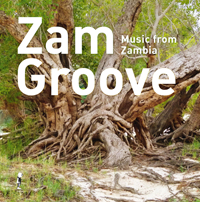
|
Drummer Michael Baird was born in Lusaka, Zambia when it was called Northern Rhodesia. He returns regularly to set foot on his native soil and to record traditional music which is still heard in the bush in this largely rural country. No one alive is as devoted to the folk music of Africa that I know of. Baird has diligently reissued the work of pioneer South African producer Hugh Tracey in greatly augmented CDs and LPs from Sharp Wood Productions and continues to produce breathtaking albums of music that is being left behind in the rush to modernity by countries anxious to get on with assimilating the constructs of Western sillivization. This short but sweet seven track LP (also available on bandcamp for download) is a very choice selection of the best music you could hope to find there today. There are two trance cuts from Crispin Mutanuka, master of the Leya xylophone, with percussion and voice. Then two wonderful songs from Mufrika Edward who accompanies his singing on the kalimba (thumb piano, or lamellophone), including the lovely "Titwe," which is easy to put on repeat. The B side contains three examples of Barotse guitar style from Lipa Band and Libala Band. These songs, with percussion on a tapped glass bottle, recall the early 50s recordings of Hugh Tracey. The vinyl is bargain priced if you prefer tangibles. This album also serves as a highly condensed sampler from two new CD and booklet packages (also reviewed on the Zambia page). . |
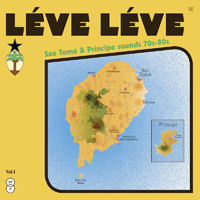
|
LEVE LEVE
SAO TOME & PRINCIPE SOUNDS 70S-80S vol 1 (Bongo Joe)
I jump on anything from São Tomé and Principe, tiny islands in the Atlantic off the coast of Gabon, which were colonized by Portugal. You have probably heard of Africa Negra, but there are many other wonderful bands from these islands, including Sangazuza, Os Untuès, Pedro Lima and Conjunto Mindelo. They are all here in this great, clear compilation. The title means "Take it easy," and sums up the attitude of the islanders whose music has echoes of Brasil, Angola and Cabo Verde, all of which share a language and colonial history. Slaves were brought there to work cocoa plantations and their rhythms and songs became mixed in with European popular music and echoes from other Lusophone countries. This album collects singles from 1978-89, assembled by a French DJ called Tom B who went there crate digging and to track down artists. The Africa Negra & Sangazuza tracks have all been collected on CD before now (including the smash hit "Aninha"); that leaves 11 tracks that are new to me and a welcome hour of warmth from the chocolate isles. Conjunto Equador are a pleasant surprise: familiar sound but with a sparkling lead guitar. In my original review I said Pedro Lima deserves his own reissue, and sure enough Bongo Joe followed up with exactly that. . |
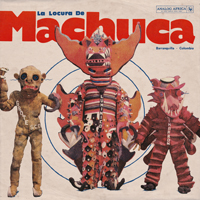
|
LA LOCURA DE MACHUCA (Analog Africa AA30)
After a long stay in Benin, trips to Ghana, Angola and other parts of Africa, Analog's Samy ben Redjeb has returned to Barranquilla, from whence he delivered the Aníbal Velásquez Mambo Loco, to discover the earthy funky punk sounds of Machuca. A decade ago, Samy teamed up with the renowned Colombian producer Lucas Silva for the Diablos del Ritmo compilation, and now he and Lucas have unearthed the story of an obscure record label, Machuca, and their diverse catalogue. When they succeeded with traditional cumbia, vallenato or porro songs, Machuca's owners also took a chance on more experimental bands they knew wouldn't sell as well, just for the pleasure of releasing them. So rootsy funk and psychedelic rock bands, inspired by African LPs bartered by visiting mariners, appeared on their label too. Shakara by Fela Kuti was one of the biggest underground hits in Barranquilla at the time and echoes of it are apparent in "Le Mongui" by King Somalie. The legendary Abelardo Carbonó was called on to add his psychedelic guitar while rhythm sections were beefed up by personnel from other bands. The result was that indigenous versions of African hits that were championed (and jealously guarded) by the picotero sound systems were now widely available. The sound engineer (poached from Discos Tropical) described the productions as the "B-movies of Colombian music." Though the connections are not made explicit you can tell there are African originals of some of the tracks on here: "Caracol" by Grupo Bola Roja is a remake of Miriam Makeba's "Pata Pata." The singer Amina Jiménez was renamed Mirian Makenwa for marketing purposes! I immediately spotted a mento tune "Fat Beef" by the Tellers from Jamaica, remade as "Ayu" by Rio Latino. "Juipiti," attributed to El Grupo Folclórico is no more than a riff, sustained for two and a half minutes, like one of those danceable grooves the deejays like to loop once they have a full floor. Abelardo Carbonó delivers his very catchy "A otro perro con ese hueso (a different dog for that bone)," (i.e. you can't fool me) with its guitar intro I can't quite place, maybe Led Zep? Like the Machuca label itself this compilation is diverse and quirky and delivers many aural surprises along the way. . |
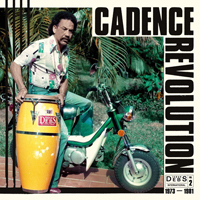
|
DISQUES DEBS
CADENCE REVOLUTION (Strut)
Spanning the years 1973-1982 -- a golden decade for Caribbean music -- this CD presents the big names like Super Combo, Les Vikings, Guy Conquette and Ti Celeste, along with some lesser-known but compelling exponents of Ka-Dans, or Cadence, from the Disques Debs catalogue. This sound came from the French-speaking islands of Guadeloupe and Martinique and held its own against rival influences coming from Haiti (mini-Jazz), Puerto Rico (salsa), Trinidad (Calypso, Soca) and Jamaica (Reggae). Nevertheless, cadence is a descendent of compas from Haiti, a stylistic neighbor of Dominican merengue and includes dashes of many cultures. Haitian mini-jazz (typified by Nemours Jean-Baptiste) evolved out of economic necessity from big bands when the horns and percussion section were replaced by keyboards, kit drums and electric guitars. The Cadence bands restored the horns and took salsa as their inspiration for the brass section (copying Willie Colón). Henri Debs (whose catalogue is the basis for this reissue) turned to the LP format to give bands he recorded room to breathe and stretch out which was important to keep the dance floor moving. He had a house band of sax, bass, drums and conguero who could be called on to add some beef to visiting groups. In addition there was another outside influence in the form of Congolese supergroup Ryco Jazz who came on tour in 1967 and stayed for several years. They created a hybrid band called Guadafrica (new to me) who can be heard here. And many musicians went on tour to Paris, some of them staying there to entertain the expat audience. Most of the groups presented here performed at big day-long festivals with other bands and this led to cross-fertilization of ideas. This is a brilliant brightly lit snapshot of Cadence at its peak. In the 80s new influences, such as funk, took root in the Caribbean islands, however Galaxy's 1977 track entitled "Disco funk" is actually an entertaining exercise in speed and aural dynamics. While there are merengues and characteristic examples of "mini jazz," such as Smoke's "Lina femm' foll" and Rico's "Pas coler la," there are also many outstanding and innovative cuts: Koumbit's "Lagé yo" breaks down to clapping and percussion and fades out all too soon; there is even a reggae track: a Wailers' style groove called "Stranger" by Midnight Groovers. One of the highlights is Guy Conquette's "Ping pong," a 45 from 1975. While there is no suggestion of religious ritual (like Santería) being behind any of the music, this starts with wild yelling and a drum workout before electric piano that is positively possessed comes in. All round this is a fine compilation. . |
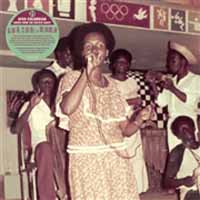
|
A double album of Afro-Colombian music from the Pacific Coast of Colombia is the latest work of Lucas Silva, taking time out from his own Palenque label to help out Vampisoul in their ongoing exploration of all aspects of Latin music. This double-LP set covers the 1970s through the end of the last century. Percussion (hand drums) is to the fore and the featured groups offer vocals and instruments as diverse as marimba and euphonium. The Pacific Coast of Colombia is a dense rain forest and was home to runaway slaves so the population remained 90% African and 10% indigenous people. While cumbia dominated the rest of the country (and was gradually infiltrated by salsa), drumming and ritual music, influenced by local shamanic traditions as much as African heritage, remained the dominant sound of the forest. Eventually military brass began to infiltrate as radio made inroads in the mid twentieth century, hence the presence of clarinet and euphonium. Peregoya & his combo Vacaná are here with the exciting "Sácale Brillo Teresa" driven by wild sax and guitar and a jamming percussion section. They are joined by less well-known acts including the singer Gertrudis Bonilla. I am particularly taken with Chencho Trompeta y los Brujos del Folklore, first for their name (there's no trumpet, but they are truly "warlocks of folklore"), then for their insistent marimba continuo. Their track "La Logia" is over 13 minutes long, whereas most of the rest are between 2 and 4 minutes. Cumbia does make an appearance with La Sonora del Pacífico, who get three cuts. La Contundencia have charmingly persistent vocals and make a couple of appearances. "Kilele" has a solid groove, again, with horn soloists. In a typical "smaller" lineup, I hear timbales, congas, guiro, bass drum, solo electric guitar and agogo, which certainly came from Africa, backing Gertrudis Bonilla. This is a varied set of great strength and diversity, well-sequenced and extremely enjoyable.
. |

|
JOHN COLTRANE QUARTET
BLUE WORLD (Impulse)
On the rare occasions when we went to the cinema in my childhood (at a town 4 miles away), we just showed up, bought tickets and went in. Sometimes they were showing a newsreel or the cartoon was on, or the feature might have already started, but it didn't matter. You sat through the show and then when it got back to the part you recognized you said, This is where we came in, got up and left. As jazz historians unearth rare discoveries of lost tapes by the past masters, Miles, Monk, Stan Getz, Trane and so on I kept up with it, until I felt it was getting a bit silly and decided this was where I came in and had heard the rest. For example, Craft recently reissued the 1958 Prestige sessions of Coltrane's works, essentially duplicating parts of Side Steps and Fearless Leader, and now Impulse have found another lost Trane session with the classic quartet. I looked at it and thought, hmmm, I have all this, and if it's anything like the Monk "Liaisons Dangereuses" soundtrack not particularly thrilling, even for a completist. "Liaisons Dangereuses" was marketed as a discovery of a lost soundtrack -- French and from the same period as the astounding Elevator to the Gallows of Miles, even featuring the French tenor player Barney Wilen who had accompanied Miles. But in fact it was Monk doing what he does: playing his set, which has been documented on many live albums. So I decided to hold off on Blue World, making another mistake. First, mid-60s Coltrane was rippingly good (he had given up exploring the avant garde with Dolphy after Down Beat called it "Anti-jazz," and was retrenching by exploring ballads), and even though there are live concerts from this period (the magnificent Live at Birdland), there are only two studio recordings that year, including A Love Supreme where his spiritual concerns begin to manifest. What is going on here with Blue World is a serious request from a Canadian filmmaker for Trane to play a setlist of a few of his classics from Atlantic 1959-60 to be used in a film (which was in French so got limited notice outside the Francophile world). Unlike Monk, Trane did not revisit his old repertoire much. The hauntingly lovely "Naima" did feature at the Village Vanguard in 1961 and on the European tours of the next couple of years. Of the other material here, only "Traneing in" showed up on a date in Europe 1962. For once I am happy to listen to some fresh takes of his back catalogue over and over again. It's a crystal clear recording and the set, all Coltrane compositions, is very coherent.
. |
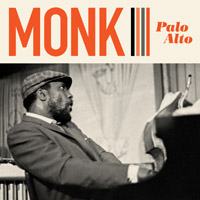
|
THELONIOUS MONK QUARTET
PALO ALTO (Impulse/Legacy)
This newly discovered Monk Palo Alto high school gig from 1968 is another genuine lost gem with Monk in fine form. It's 47 minutes of essential Monk -- four tunes plus his outtro music "Epistrophy" and a coda. In his career, starting with Coleman Hawkins in the 40s, Monk accompanied the finest tenor saxophone players of the post-War era, John Coltrane and Sonny Rollins, both of whom grew in his band. But mostly he was accompanied by Charlie Rouse, who fits the bill perfectly. Rouse doesn't showboat, he understands the music, he plays relatively straightforward solos, reading the charts, and lets Monk do the far-out stuff.
In 1968 Monk's career was winding down. His label, Columbia were not happy that he kept re-recording his own tunes, wanted him to try the Beatles songbook to spice things up. "Eleanor Rigby"? Maybe, "Yellow submarine"? No way. Actually I have massive respect for Monk as a recording artist: he wrote about 60 tunes and while he did record them over and over, and they formed his key repertoire, they evolved. Also, he always threw in a Tin Pan Alley song, like "Sweetheart of all my dreams," "Lulu's back in town" or "Tea for two," to show how he related to other's phrasing. This is very instructive. Furthermore, can you really see him standing next to the piano like Lee Liberace and saying, Now, for a special treat, we take you back to one of my classics, "Round Midnight"! His first two Riverside albums were all covers: the brilliant set of Duke Ellington which announced Monk with a bang, and a follow-up The Unique Thelonious Monk, which showcased Gershwin, Fats Waller, Rodgers & Hart. It would have been great to have a whole album of Harry Warren, or James P. Johnson material, but I am not complaining.
In the snippets of Teo Macero you see in the various documentary footage of Monk, the producer comes across as a buffoon who is indulging his pet bear without really trusting him. Monk's last album for Columbia, Underground, contained new music and appeared in 1968. That album won a Grammy -- for the cover art, not the content, and the cover led to the foolish notion that Monk had fought in the French Resistance during World War II. Monk did not go on a promotional tour, as you would expect, instead he went into a long depression that kept him silent for the rest of his life, with the exception of a single date at Chappell studios in London in November 1971. In 1968 in fact he had a seizure and was misdiagnosed by doctors. He missed recording dates which meant he went into debt to the label, which was why he needed to play a long stand in a friendly spot like the Jazz Workshop. He lived another 14 years but even as his fame increased, so did his isolation. Columbia filled the void and the demand for his work by issuing live gigs, such as Live in Tokyo (from 1963) the It Club, and the Jazz Workshop (1964) sets.
But he was alive and well when a kid from Palo Alto contacted his manager to see if he would play a gig at the high school. As the quartet was making a trip out for a three-week stand at the Jazz Workshop in San Francisco, they thought it would work out fine. And then, as luck would have it, the old janitor was a music buff and had a recording setup (aside: my uncle worked at Ampex in Palo Alto, developing tape recording technology in the 60s). The janitor said he would tape the gig if the school got the piano tuned. Tickets were $2 but no one bought advance tickets figuring it had to be a hoax. Then on the night of the gig, the band arrived in the high school parking lot (driven down by a student, the bass sticking out the window) and there was a rush to get in and hear them. Everyone is having fun, Ben Riley and Larry Gales, the rhythm section, swing hard and this may be the last time we hear the "classic quartet" as they became known, in top gear driving form. It's the same band who freshly assembled were recorded live in LA at the It Club on Hallowe'en 1964, and the next night, and then again the following two nights in San Francisco at the Jazz Workshop in 1964, so you can compare these 1968 versions to those, if you want. Well, apart from the opener which is a lovely 7-minute take of the ballad "Ruby, my dear." One of Monk's first compositions, he wrote it for his first girlfriend when he was a teenager. There is a resounding "Well you needn't," followed by a solo "Don't blame me," which is so sharply recorded you can hear Monk's shoe on the floor adding his invisible two-step organ pedal percussion. This is a classic of his solo style: womping stride chords in the left hand and death-defying whole-tone runs in the right against a lop-sided rhythm. His sense of time was unique, imagine you are swaying from side to side and your arms are swinging unconsciously by your side, hanging loose. The audience is attentive and digging it, they applaud the bass solo by Larry Gales in "Blue Monk," then go nuts for Ben Riley's drum solo before the resolution. It's all over too quickly, and then applause flares up and down as there's a solo taste of "Sweetheart of all my dreams," which sounds like the piano is being wheeled off stage, and a final comment "We have to hurry back and get to work..."
|
